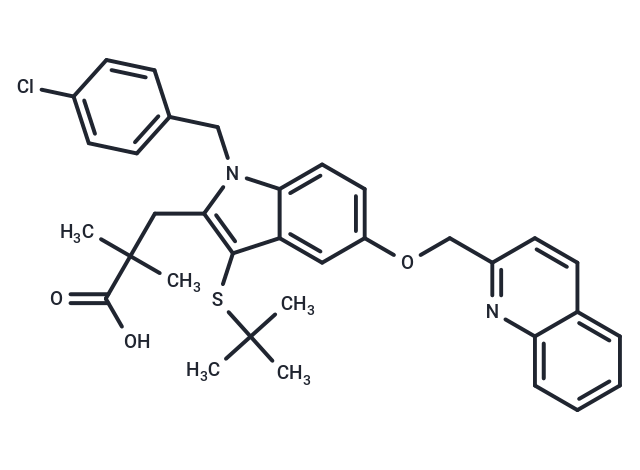Shopping Cart
- Remove All
 Your shopping cart is currently empty
Your shopping cart is currently empty

Quiflapon (MK-591) causes cell apoptosis. Quiflapon is a selective and specific 5-lipoxygenase-activating protein (FLAP) inhibitor (IC50: 1.6 nM in a FLAP binding assay) and is also an effective and orally active Leukotriene biosynthesis (LT) inhibitor (IC50: 3.1 and 6.1 nM in intact human and elicited rat PMNLs, respectively).

| Pack Size | Price | Availability | Quantity |
|---|---|---|---|
| 2 mg | $31 | In Stock | |
| 5 mg | $46 | In Stock | |
| 10 mg | $65 | In Stock | |
| 25 mg | $143 | In Stock | |
| 50 mg | $227 | In Stock | |
| 1 mL x 10 mM (in DMSO) | $60 | In Stock |
| Description | Quiflapon (MK-591) causes cell apoptosis. Quiflapon is a selective and specific 5-lipoxygenase-activating protein (FLAP) inhibitor (IC50: 1.6 nM in a FLAP binding assay) and is also an effective and orally active Leukotriene biosynthesis (LT) inhibitor (IC50: 3.1 and 6.1 nM in intact human and elicited rat PMNLs, respectively). |
| Targets&IC50 | FLAP:1.6 nM |
| In vitro | Quiflapon is an effective inhibitor of leukotriene (LT) biosynthesis in the human, squirrel monkey, and rat whole blood (IC50: 510, 69, and 9 nM, respectively). Quiflapon has a high affinity for 5-lipoxygenase activating protein (FLAP) as evidenced by an IC50 value of 1.6 nM in a FLAP binding assay and inhibition of the photoaffinity labeling of FLAP by two different photoaffinity ligands. However, Quiflapon has no effect on rat 5-lipoxygenase. The inhibition of activation of 5-lipoxygenase was shown through inhibition of the translocation of the enzyme from the cytosol to the membrane in human PMNLs[1]. |
| In vivo | Pups were treated with either vehicle or Quiflapon(10, 20, or 40 mg/kg; daily for days 1-4, 5-9, or 10-14) subcutaneously. On day 14, the lungs were inflated, fixed, and stained for histopathological and morphometric analyses. Inhibition of antigen-induced bronchoconstriction by Quiflapon is observed in inbred rats pretreated with methysergide, Ascaris-challenged squirrel monkeys, and Ascaris-challenged sheep (early and late phase response) [1]. Hyperoxia groups treated with Quiflapon untreated hyperoxia groups displayed definite evidence of aberrant alveolarization but no inflammation[2]. |
| Alias | MK-591 |
| Molecular Weight | 587.17 |
| Formula | C34H35ClN2O3S |
| Cas No. | 136668-42-3 |
| Smiles | CC(C)(C)Sc1c(CC(C)(C)C(O)=O)n(Cc2ccc(Cl)cc2)c2ccc(OCc3ccc4ccccc4n3)cc12 |
| Relative Density. | 1.21g/cm3 |
| Storage | Powder: -20°C for 3 years | In solvent: -80°C for 1 year | Shipping with blue ice. | ||||||||||||||||||||||||||||||
| Solubility Information | DMSO: ≥ 50 mg/mL (85.15 mM) H2O: < 0.1 mg/mL (insoluble) | ||||||||||||||||||||||||||||||
Solution Preparation Table | |||||||||||||||||||||||||||||||
DMSO
| |||||||||||||||||||||||||||||||

Copyright © 2015-2024 TargetMol Chemicals Inc. All Rights Reserved.